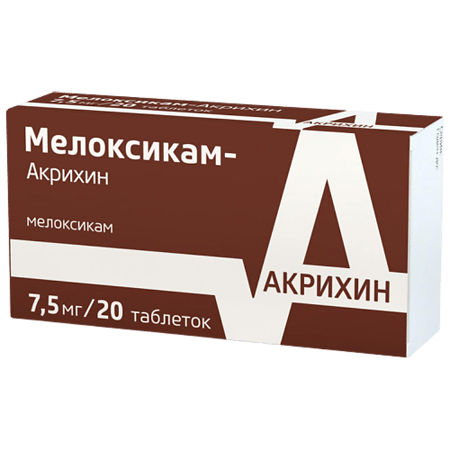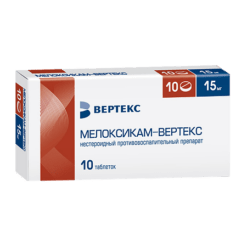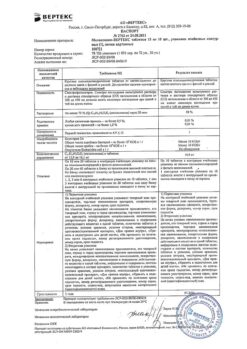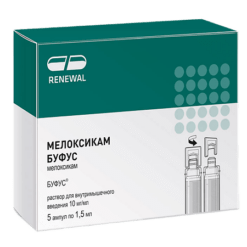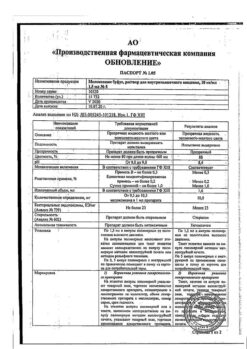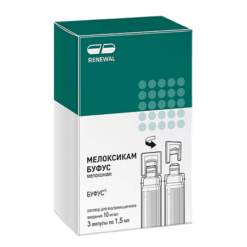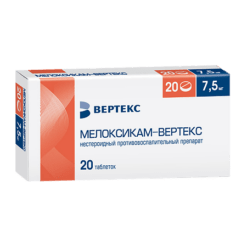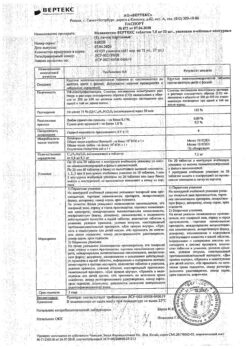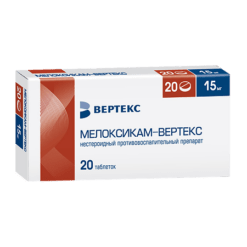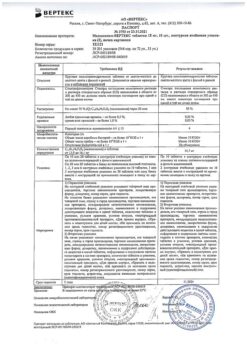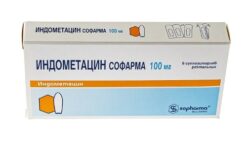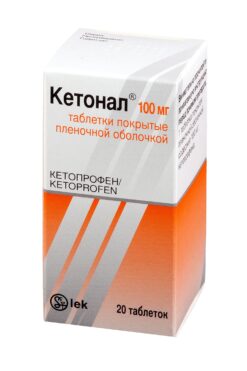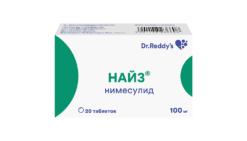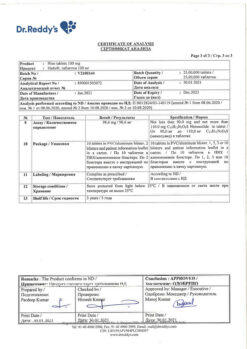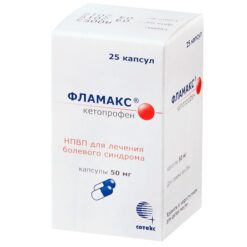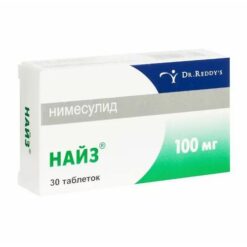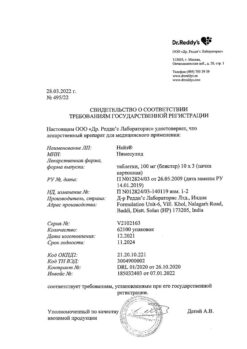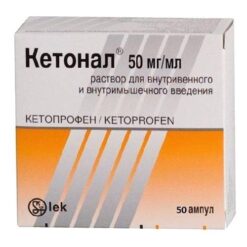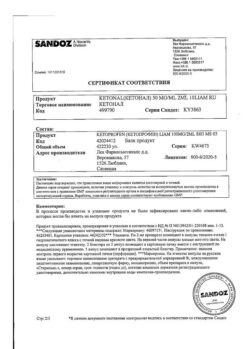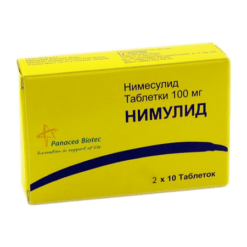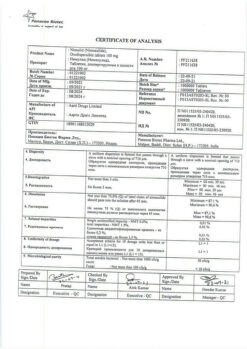No products in the cart.
Meloxicam-Acrihin, tablets 7.5 mg 20 pcs
€1.00
Out of stock
(E-mail when Stock is available)
Description Pharmacotherapeutic group: NSAIDs Pharmacodynamics:
ATC:
M.01.A.C.06 Meloxicam
M.01..A.C Oxycams
Meloxicam is a nonsteroidal anti-inflammatory drug with analgesic, anti-inflammatory and antipyretic effects.
The anti-inflammatory action is associated with inhibition of the enzymatic activity of cyclooxygenase-2 (COX-2), involved in the biosynthesis of prostaglandins in the area of inflammation. To a lesser extent, meloxicam acts on cyclooxygenase-1 (COX-1), which is involved in the synthesis of prostaglandin that protects the mucosa of the gastrointestinal tract (GIT) and is involved in the regulation of blood flow in the kidneys.
Pharmacokinetics:
Absorption
It is well absorbed from the gastrointestinal tract, the absolute bioavailability of meloxicam is 89%. Simultaneous intake of food does not change absorption. When the drug is used orally in doses of 7.5 and 15 mg, its concentrations are proportional to the doses. Equilibrium concentrations are reached within 3-5 days. With long-term use of the drug (more than 1 year), the concentrations are similar to those observed after first reaching a steady state pharmacokinetics.
Distribution
The binding to plasma proteins is more than 99%. The range of differences between maximal and basal concentrations of the drug after its administration once a day is relatively small and amounts to 0.4-1.0 µg/ml with 7.5 mg dose and 0.8-2.0 µg/ml with 15 mg dose (Cmin and Cmax values are given, respectively).
Meloxicam penetrates the histohematic barriers, the concentration in synovial fluid reaches 50% of the maximum blood plasma concentration of the drug.
Metabolism
Meloxicam is almost completely metabolized in the liver to form four pharmacologically inactive derivatives. The main metabolite, 5′-carboxymeloxicam (60% of the dose value), is formed by oxidation of the intermediate metabolite, 5′-hydroxymethylmeloxicam (9% of the administered dose). In vitro studies have shown that CYP2C9 isoenzyme plays an important role in this metabolic transformation, CYP3A4 isoenzyme has additional importance. Peroxidase, the activity of which probably varies individually, is involved in the formation of the other two metabolites, which are, respectively, 16% and 4% of the value of the drug dose).
Extracted equally in the feces and urine, mainly as metabolites. Less than 5% of daily dose is excreted unchanged in the feces; in urine the drug is excreted unchanged only in trace amounts.
Half-life period (T1/2) of meloxicam is 15-20 hours. Plasma clearance averages 8 ml/min.
In elderly persons the drug clearance is decreased.
The volume of distribution is low and averages 11 liters.
.
Indications
Indications
Symptomatic treatment:
Active ingredient
Active ingredient
Composition
Composition
1 tablet (7.5 mg) contains:
The active ingredient:
meloxicam – 7.50 mg.
Excipients:
lactose monohydrate – 182.65 mg,
microcrystalline cellulose – 37.50 mg,
sodium citrate – 11.10 mg,
crospovidone – 7.50 mg,
colloidal silicon dioxide – 2.50 mg,
magnesium stearate – 1.25 mg.
How to take, the dosage
How to take, the dosage
Ingestion. The daily dose should be taken in one meal with water or other liquids. The maximum recommended daily dose is 15 mg.
Because the potential risk of adverse reactions depends on the dose and duration of treatment, the lowest possible dose and length of use should be used.
In osteoarthritis, the recommended dose is 7.5 mg daily. If necessary, this dose can be increased to 15 mg per day.
In rheumatoid arthritis, the recommended dose is 15 mg daily. Depending on the therapeutic effect, the dose may be reduced to 7.5 mg per day.
In ankylosing spondylitis, the recommended dose is 15 mg daily. Depending on the therapeutic effect, the dose may be reduced to 7.5 mg per day.
In patients with an increased risk of adverse reactions (history of gastrointestinal disorders, presence of cardiovascular risk factors), it is recommended to start treatment with a dose of 7.5 mg daily (see “Special Precautions”).
In patients with significant renal impairment who are on hemodialysis, the dose should not exceed 7.5 mg per day.
The drug should not be used simultaneously with other NSAIDs. The total daily dose of meloxicam used in different dosage forms should not exceed 15 mg.
Children over 12 years of age
The maximum daily dose in adolescents (12-18 years of age) is 0.25 mg/kg and should not exceed 15 mg.
Interaction
Interaction
Other prostaglandin synthesis inhibitors, including glucocorticoids and salicylates – concomitant use with meloxicam increases the risk of gastrointestinal ulcers and gastrointestinal bleeding (due to synergistic action).
Simultaneous use with other NSAIDs is not recommended.
Anticoagulants for oral administration, heparin for systemic use, thrombolytics – simultaneous use with meloxicam increases the risk of bleeding. In case of concomitant use it is necessary to monitor the blood clotting system.
Antiplatelet agents, serotonin reuptake inhibitors – concomitant use with meloxicam increases the risk of bleeding due to inhibition of platelet function. In case of concomitant use, close monitoring of the clotting system is necessary.
Lithium drugs – NSAIDs increase plasma levels of lithium by reducing its excretion by the kidneys. Concomitant use of meloxicam with lithium drugs is not recommended. If concomitant use is necessary, it is recommended to carefully monitor the concentration of lithium in plasma throughout the course of lithium drugs.
Methotrexate – NSAIDs reduce renal secretion of methotrexate, thereby increasing its plasma concentrations. Concomitant use of meloxicam and methotrexate (in dose more than 15 mg per week) is not recommended. In case of concomitant use, careful monitoring of renal function and blood counts is required. Meloxicam may increase hematological toxicity of methotrexate, especially in patients with impaired renal function. If meloxicam and methotrexate are used together for 3 days, there is an increased risk of increased toxicity of the latter.
Contraception – there is evidence that NSAIDs may reduce the effectiveness of intrauterine contraceptive devices, but this has not been proven.
Diuretics – the use of NSAIDs in patients who are dehydrated is accompanied by a risk of acute renal failure.
Antihypertensive agents (beta-adrenoblockers, angiotensin-converting enzyme inhibitors, vasodilators, diuretics). NSAIDs reduce the effect of antihypertensive drugs, due to inhibition of prostaglandins that have vasodilatory properties.
Angiotensin II receptor antagonists, as well as angiotensin-converting enzyme inhibitors when combined with NSAIDs increase decrease of glomerular filtration, which may lead to acute renal failure, especially in patients with impaired renal function.
NSAIDs, by acting on renal prostaglandins, may increase the nephrotoxicity of cyclosporine.
Deferasirox – Caution should be exercised when using meloxicam and deferasirox concomitantly, as the risk of gastrointestinal adverse reactions may increase.
Pemetrexed – When concomitant use of meloxicam and pemetrexed in patients with a creatinine clearance of 45 to 79 ml/min, meloxicam should be discontinued five days before starting pemetrexed and possibly resumed 2 days after the end of the drug. If there is a need for co-administration of meloxicam and pemetrexed, patients should be closely monitored, especially with regard to myelosuppression and the occurrence of gastrointestinal side effects. In patients with a creatinine clearance of less than 45 mL/min, the use of meloxicam with pemetrexed is not recommended.
When using together with meloxicam the medicinal products with known ability to inhibit CYP2C9 and/or CYP3A4 (or metabolized with the participation of these enzymes), such as sulfonylurea derivatives or probenecid, the possibility of pharmacokinetic interaction should be taken into account.
No significant pharmacokinetic interactions have been found with concomitant use of antacids, cimetidine, digoxin and furosemide.
Special Instructions
Special Instructions
Patients with gastrointestinal diseases should be monitored regularly. If gastrointestinal ulceration or gastrointestinal bleeding occurs, the drug should be discontinued. Gastrointestinal ulcers, perforations or bleeding may occur at any time during treatment, either in the presence of alarming symptoms or a history of serious gastrointestinal complications or in the absence of these signs. The consequences of these complications are generally more serious in the elderly.
Serious skin reactions such as exfoliative dermatitis, Stevens-Johnson syndrome, toxic epidermal necrolysis may develop when using the drug. Therefore, special attention should be paid to patients who report the development of adverse reactions of the skin and mucous membranes, as well as hypersensitivity reactions to the drug, especially if such reactions were observed during the previous courses of treatment. The development of such reactions is usually observed during the first month of treatment. If the first signs of skin rash, mucous membrane changes or other signs of hypersensitivity appear, the discontinuation of the drug should be considered.
In cases of increased risk of serious cardiovascular thrombosis, myocardial infarction, angina attack, possibly with fatal outcome, have been described when taking NSAIDs. This risk increases with long-term use of the drug, as well as in patients with the above-mentioned diseases in the history and predisposition to such diseases.
NSAIDs inhibit the renal synthesis of prostaglandins, which are involved in maintaining renal perfusion. Use of NSAIDs in patients with decreased renal blood flow or reduced circulating blood volume may lead to decompensation of latent renal insufficiency. After discontinuation of NSAIDs, renal function usually recovers to baseline levels. Elderly patients, patients with dehydration, congestive heart failure, cirrhosis, nephrotic syndrome or acute renal dysfunction, patients simultaneously taking diuretics, ACE inhibitors, angiotensin II receptor antagonists, and patients who have undergone serious surgical interventions that lead to hypovolemia, are at highest risk for this reaction. In such patients, diuresis and renal function should be carefully monitored at the beginning of therapy.
The use of NSAIDs together with diuretics may lead to retention of sodium, potassium and water, as well as to reduction of the natriuretic action of diuretics. As a result, in predisposed patients there may be increased signs of heart failure or arterial hypertension. Therefore, close monitoring of such patients is necessary, and adequate hydration should be maintained.
Before initiating treatment, renal function should be studied. In case of combined therapy, renal function should also be monitored.
When using the drug (as well as most other NSAIDs) there may be occasional increases in serum transaminase activity or other liver function parameters. In most cases this increase was small and transient. If the changes detected are significant or do not diminish over time, the drug should be discontinued, and the laboratory changes detected should be monitored.
Weakened or debilitated patients may have a worse tolerance to adverse events, and therefore these patients should be closely monitored.
Like other NSAIDs, Meloxicam-Acrichine may mask symptoms of infectious diseases.
In patients with mild to moderate renal impairment (creatinine clearance greater than 25 mL/min), no dose adjustment is required.
In patients on dialysis, the dose of the drug should not exceed 7.5 mg/day.
In patients with cirrhosis (compensated) no dose adjustment is required.
The use of meloxicam, as well as other drugs that block the synthesis of prostaglandins, may affect fertility, so it is not recommended for women who want to get pregnant.
Special clinical studies of the effect of the drug on the ability to drive and operate machinery have not been conducted. However, when driving or operating machinery, the possibility of dizziness, drowsiness, visual disturbances or other disorders of the central nervous system should be taken into account. Patients should use caution when driving and operating machinery.
Synopsis
Synopsis
Contraindications
Contraindications
– Hypersensitivity to the active ingredient or excipients of the drug;
– Complete or incomplete combination of bronchial asthma, recurrent nasal and paranasal sinus polyposis, angioedema or urticaria caused by intolerance to acetylsalicylic acid or other non-steroidal anti-inflammatory drugs because of the potential for cross-sensitivity (includingÑ. history);
– gastric and duodenal erosive-ulcerative lesions with acute or recent history;
– inflammatory bowel disease – Crohn’s disease or acute ulcerative colitis;
– severe hepatic impairment;
– severe renal impairment (unless hemodialysis, creatinine clearance less than 30 ml/min, and with confirmed hyperkalemia), advanced renal disease;
– active gastrointestinal bleeding, recent history of cerebrovascular bleeding or established diagnosis of blood clotting disorders;
– significant uncontrolled heart failure;
– pregnancy;
p> – breastfeeding;
– therapy for perioperative pain during coronary artery bypass grafting;
– Children under 12 years of age;
– rare hereditary galactose intolerance, lactase deficiency, glucose-galactose malabsorption.
Side effects
Side effects
The following are the side effects that have been considered possible due to the use of the drug.
The side effects reported in post-marketing use that were considered to have a possible association with the use of the drug are marked with a *.
The following categories are used within the system-organ classes for the frequency of side effects: Very common (â¥1/10); common (â¥1/100, <1/10); infrequent (â¥1/1000, <1/100), rare (â¥1/10000, <1/1000), very rare ( <1/10000), frequency unknown (cannot estimate incidence based on available data).
Blood and lymphatic system disorders: infrequent – anemia; rare – changes in blood cell count, including changes in the leukocytic formula, leukopenia, thrombocytopenia.
The immune system: infrequent – other reactions of immediate hypersensitivity type*; frequency unknown – anaphylactic shock*, anaphylactoid reactions*.
Nervous system disorders: frequent – headache; infrequent – dizziness, somnolence.
Mental disorders: often – change in mood*; frequency unknown – confusion*, disorientation*.
Sensory organs: infrequent – vertigo; rare – conjunctivitis*, visual disturbances, including blurred vision*, tinnitus.
Gastrointestinal tract disorders: Frequent – abdominal pain, dyspepsia, diarrhea, nausea, vomiting; infrequent – latent or overt gastrointestinal bleeding, gastritis*, stomatitis, constipation, bloating, belching; rare – gastroduodenal ulcers, colitis, esophagitis; very rare – gastrointestinal tract perforation.
Hepatic disorders: infrequent transient changes in liver function parameters (e.g., increased transaminase or bilirubin activity); very rare – hepatitis*. Skin and subcutaneous tissue: infrequent – angioedema*, pruritus, skin rash; rare – toxic epidermal necrolysis*, Stevens-Johnson syndrome*, urticaria; very rare – bullous dermatitis*, erythema multiforme*; frequency unknown – photosensitization.
Respiratory system disorders: rare – bronchial asthma in patients allergic to acetylsalicylic acid or other NSAIDs.
Cardiovascular system disorders: infrequent increase in blood pressure and feeling of “rush” of blood to the face; rarely – palpitation.
Urogenital system disorders: infrequent changes in renal function (increased serum creatinine and/or serum urea levels), urinary disorders, including acute urinary retention *; very rare – acute renal failure *.
Gender and mammary gland side effects: infrequent – late ovulation*; frequency is unknown – infertility in women*.
Gastrointestinal bleeding, ulceration or perforation can be fatal.
As with other NSAIDs, the possibility of interstitial nephritis, glomerulonephritis, renal medullary necrosis, and nephrotic syndrome is not excluded.
Overdose
Overdose
There are insufficient data on cases associated with overdose of the drug. Symptoms characteristic of NSAID overdose are likely to be present, in severe cases: drowsiness, impaired consciousness, nausea, vomiting, epigastric pain, gastrointestinal bleeding, acute renal failure, changes in blood pressure, respiratory arrest, asystole.
Pregnancy use
Pregnancy use
The use of the drug Meloxicam-Acrihin is contraindicated during pregnancy.
It is known that NSAIDs penetrate into the breast milk, so the use of the drug Meloxicam-Acrihin during lactation is contraindicated.
As a drug that inhibits cyclooxygenase/prostaglandin synthesis, Meloxicam-Acrihin may affect fertility and therefore is not recommended for women planning to become pregnant. Meloxicam may cause delayed ovulation. Therefore, in women who have problems with conception and are undergoing examination for such problems, it is recommended to discontinue Meloxicam-Acrihin.
Similarities
Similarities
Additional information
| Shelf life | 3 years. Do not use after the expiration date. |
|---|---|
| Conditions of storage | In a dry, light-protected place at a temperature not exceeding 25 ° C. Contain out of reach of children. |
| Manufacturer | Unichem Laboratories Ltd, India |
| Medication form | pills |
| Brand | Unichem Laboratories Ltd |
Other forms…
Related products
Buy Meloxicam-Acrihin, tablets 7.5 mg 20 pcs with delivery to USA, UK, Europe and over 120 other countries.

